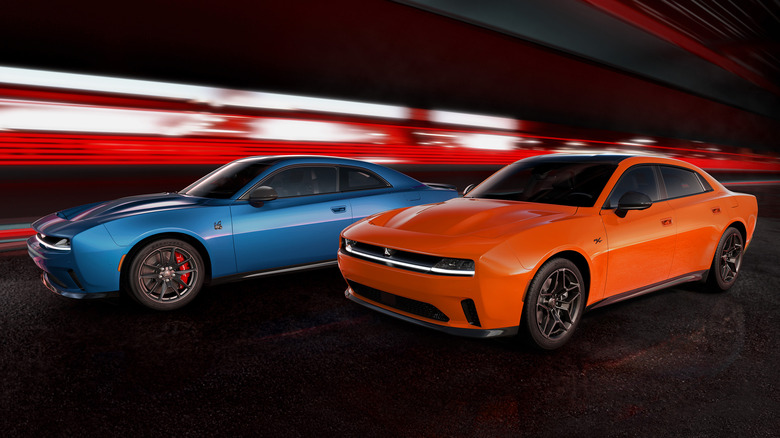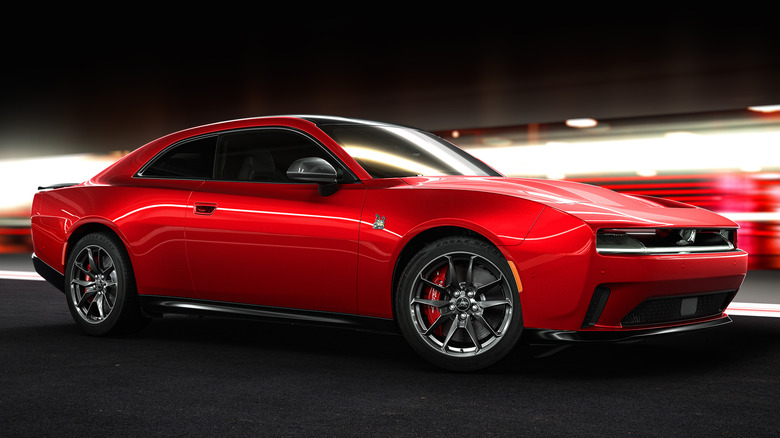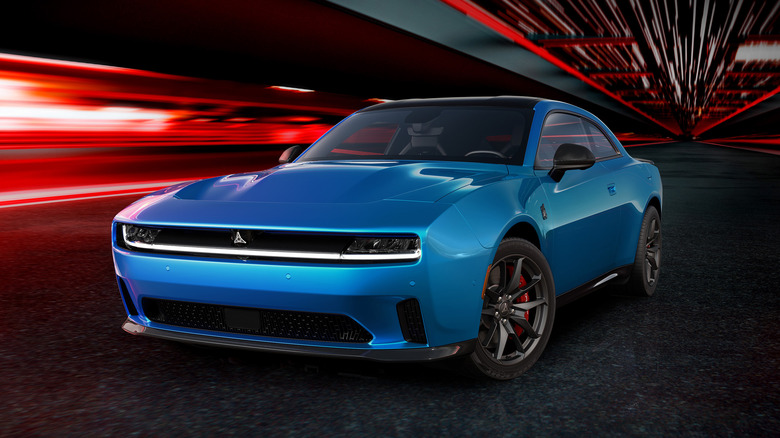What's The Difference Between The Dodge Charger R/T And Scat Pack?
Dodge has thrown out the rule book with its newest Charger, going fully electric for the first time ever. Instead of the typical internal combustion V8 you'd expect to find under the hood of a Dodge muscle car, the new 2024 Charger will be powered by electricity. Underneath the Charger's new skin, there are wires, batteries, electric motors, and 1.5 cubic-feet of cargo space in the frunk, but no internal combustion, yet. There will eventually be internal-combustion-powered versions of the Charger (called the Sixpack) but those won't arrive until at least 2025.
Two of the biggest names in Charger history lead the march towards an EV future: the Daytona R/T and the Daytona Scat Pack. Both are historical nameplates used on previous Charger (and Challenger) platforms, that denote performance differences and unique features, but what do they stand for when it comes to the EV version of the Charger? Power ratings, acceleration, and standard equipment are all slightly different when you compare these two trim levels, so let's take a closer look.
Charger R/T
Regardless of which trim level you go with, the 2024 Charger uses a large 100.5 kWh battery, dual electric motors (one front and one rear), and standard all-wheel drive. In the R/T, that combo produces 456 horsepower and 404 lb-ft of torque – but that's not all. From the factory, early R/T models will get a Direct Connection Stage 1 upgrade kit that increases power by 40 hp, delivering a maximum of 496 horses on demand. PowerShot mode, as it's called, delivers an incremental increase in horsepower for 15 seconds to give the Charger a bit more grunt.
According to Dodge, zero to 60 mph will take just 4.7 seconds, despite the R/T's significant heft — a scale-tipping curb weight of 5,838 pounds. The quarter-mile will take just 13.1 seconds. The R/T, being the more entry-level version of the Charger, doesn't get launch control, line lock, or race prep mode, but it does get Dodge's performance pages which give the driver stats about g-force and acceleration.
The Charger R/T is expected to start production soon, with two-door models coming to market first and four-door models arriving sometime in 2025. At the time of writing, the launch of the electrified Charger has been delayed, but we still expect the two-door models to arrive in the summer of 2024 and there's no doubt that many eager owners will take them to the drag strip to test out the manufacturer's claims.
Daytona Scat Pack
According to Dodge, the new electrified Charger will be even faster than the outgoing model, at least in some trims. Specifically, the new Daytona Scat Pack will be able to outrun a Hellcat Redeye. The 2023 Charger Hellcat Redeye used Dodge's supercharged 6.2-liter, 797-horsepower Hellcat engine and propelled the big sedan from zero to 60 mph in 3.6 seconds. The new electric-powered Charger Scat Pack does the same sprint in 3.3 seconds with a much smaller power rating of just 670 horses. In the quarter mile, however, the new Scat Pack will be lagging behind, with a time of 11.5 seconds compared to the old Redeye's 10.6 seconds.
Like with the R/T, the Scat Pack uses PowerShot mode for additional power during acceleration. The standard horsepower rating for the Scat Pack is 630 hp, with the PowerShot temporarily increasing power by 40 hp. The downside of this increase in power (and some of the associated performance upgrades like 305-series tires) is a loss in range. The Scat Pack gets just 260 miles of travel between charges compared to the R/T's 317-mile EPA estimate. Thankfully, both models charge just as quickly, going from 20 to 80 percent charge in about 27 minutes on a level 3 fast charger. On top of the extra power, the Scat Pack also gets stiffer spring rates, improved monotube shocks, and larger brakes at all four corners. An available Track Pack adds stickier tires, even bigger Brembo brakes and adaptive dampers.


